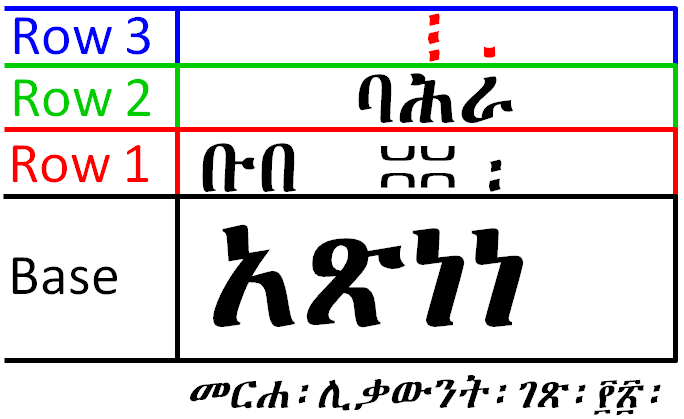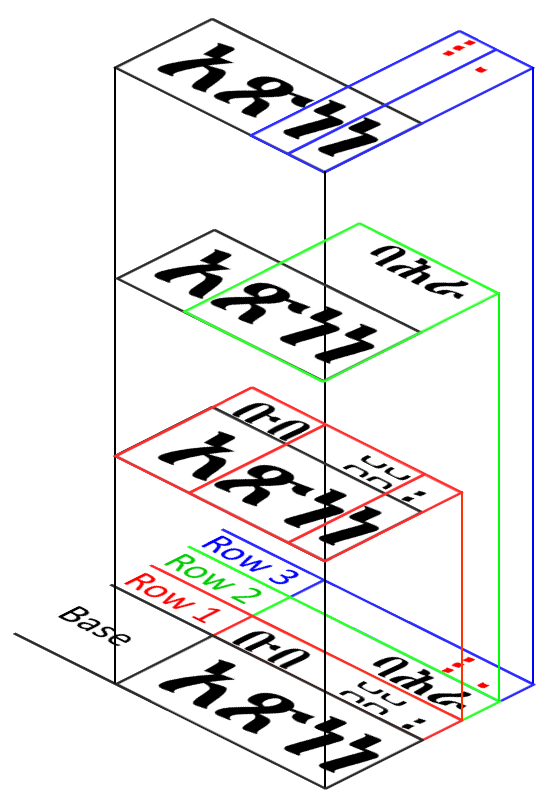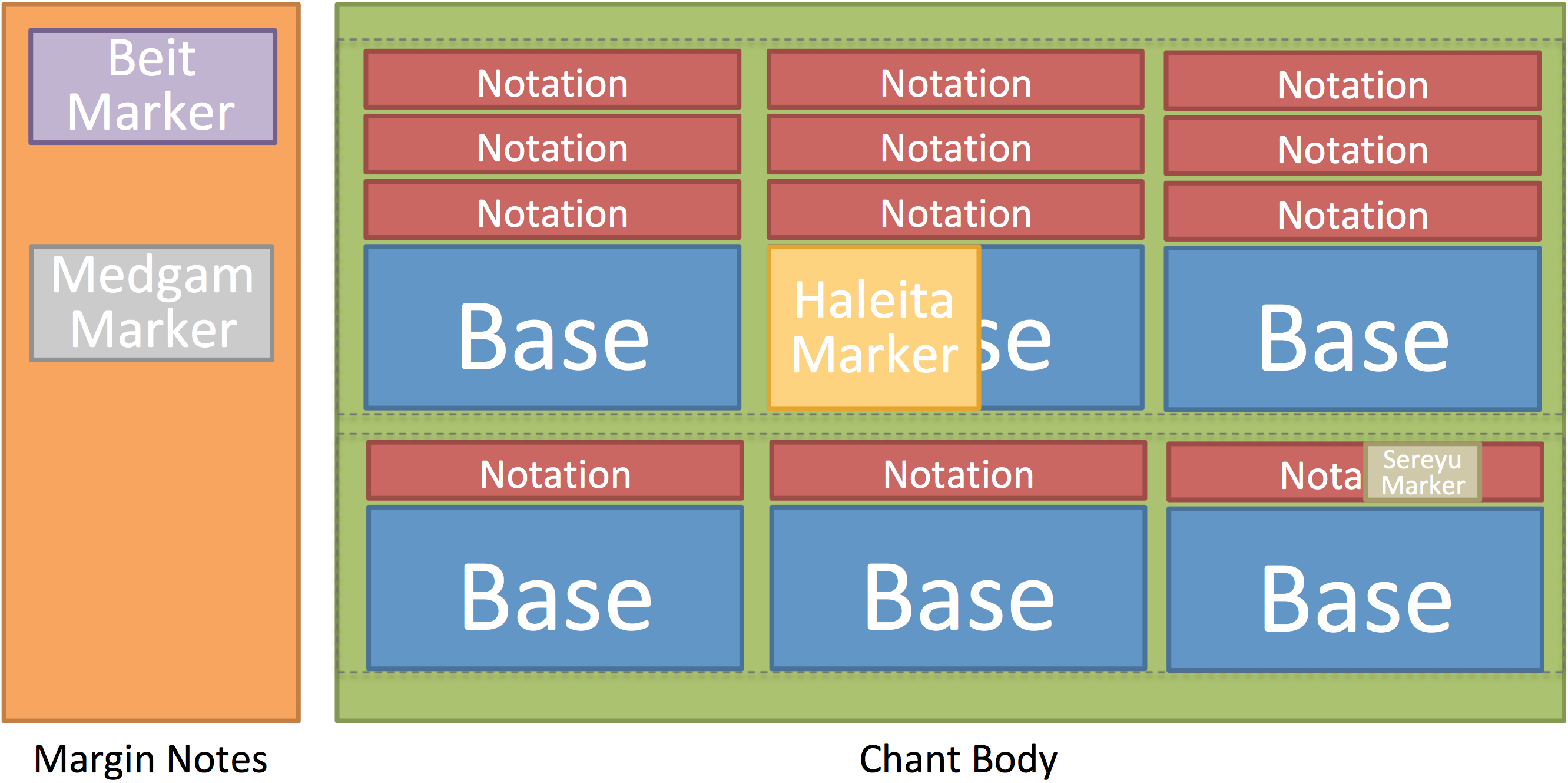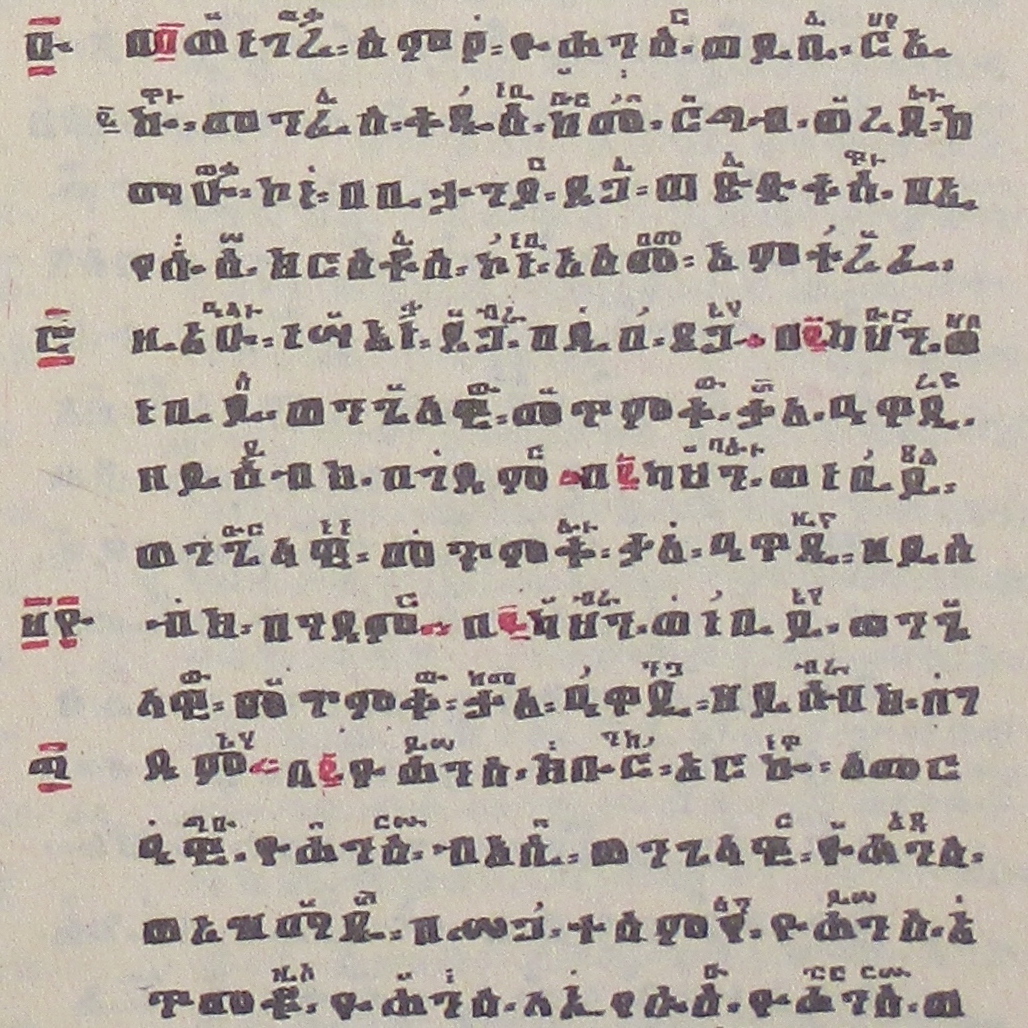A Document Model for Zaima Chant
This article assumes a strong familiarity with W3C markup and styling of Ruby annotation.
A Pragmatic Model Using Existing Standards
This section presents a model for Zaima interlinear notation that is compatible with existing W3C standards developed for the
requirements of Ruby annotation. While the objectives for Ruby annotations are entirely different from Zaima chant notations,
the two share common interlinear positioning and alignment needs. Quite naturally, many requirements for Ruby annotation are not necessary
for Zaima. Conversely, a number of Zaima layout requirements are not encountered for Ruby annotation.
The following focuses on exploiting Ruby markup, and CSS facilities, to meet the interlinear presentation requirements of Zaima chant.
Ruby and Zaima both share a requirement for the layout of half-scale interlinear text bound to one ore more letters in a line of base text.
A distinctive feature of Zaima notation that immediately distinguishes it from Ruby annotation is the regular occurrence of multiple interlinear
lines, or “rows”, of text. No upper limit is set on the number of rows a line of base Zaima may have, eight rows however have
been observed in corpus (አቋቋም፡ዘወርኃ፡በዓላት። Page 113). Multiple levels or Ruby annotation are possible but irregular. Nested Ruby markup can be used to display additional annotation levels, this
approach assumes some implicit association between the levels. In Zaima notation, the interlinear rows are fully independent from one another
and the positioning and alignment between the base text and a given row cannot be a function of any other interlinear row. Attempting to apply
the nested Ruby technique to format Zaima notation very shortly leads to complications with overlapping markup. A model for Zaima notation that is able to avoid the overlap problem treats rows as residing on separate document “layers”.
Each layer will contain the same base text and marked up with the notation of a single interlinear row. The notation line offset from the base text
is incremented in each layer. When the layers are viewed together in a projection, the base text of each layer is superimposed upon itself and
the notations appear in successive “rows”. The W3C Cascading Style Sheets standard provides the means to specify and
position layers. An example applicataion appears in Figure 4: Technical note on Figure 4: the markup sample raises the notation by shifting the ruby base A Pragmatic Model Using Existing Standards



Row 3:
<ruby>
<rb>አጽ</rb><rt></rt>
<rb>ነ</rb><rt style="color: red;">᎒</rt>
<rb>ነ</rb><rt style="color: red;">᎐</rt>
</ruby>
Row 2:
<ruby>
<rb>አ</rb><rt></rt>
<rb>ጽነነ</rb><rt>ባሕራ</rt>
</ruby>
Row 1:
<ruby>
<rb>አ</rb><rt>ቡበ</rt>
<rb>ጽነ</rb><rt style="text-align: right;"></rt>
<rb>ነ</rb><rt>᎓</rt>
</ruby>
bottom position and ruby text
along with it. A more desirable approach is to change only the bottom position of the notation text
(<rt>). Moving only the notation text is supported in Safari v11 and Chrome version 60 and earlier but requires <span>
tags within the <rt> tags to apply the bottom property style to (applying bottom to the <rt> is
ignored, thus the need for the inner <span>). Both appraoches have been applied in use case
documents (apply bottom property to notation line only ,
apply bottom property to base). Recommendations for CSS experts are needed here.
An Independent Model for Zaima Chant
A notational model for the body of a Zaima Chant document is depicted in Figure 5. The model presents a high level view of the document components that are subject to identification, layout and styling. Semantics of the components are reviewed in the What is Zaima? article. This section will detail corresponding markup elements to support the document model.

The following subsections propose HTML elements starting with those that would support interlinear layout
requirements common to many chant traditions (chant, cbase, notation, notationGroup,
and group). Elements are then introduced to support layout requirements only known to be
relevant to Zaima chant (beit, marker, medgam, sereyu and haleita).
The chant element
- Categories:
- Flow content
- Phrasing content
- Palpable content.
- Contexts in which this element can be used:
- Where phrasing content is expected.
- Content model:
- See prose.
- Content attributes:
- Global attributes
- DOM interface:
- Uses
HTMLElement.
The chant element allows one or more spans of phrasing content to be marked with chant
notations. Chant notations are short runs of text (symbols or letters representing notes) presented over base text,
primarily used to score hymns before the advent of staff lines. Staffless chant scoring is practiced
in a number of traditions, notably Byzantine, Gregorian (older form), Hebrew, Znamenny, Ge’ez, Syrian and others.
The content model of chant elements consists of one or more of the following sequences:
-
One or more phrasing content nodes.
-
One or more elements whose semantics are defined only as children of
chant:
The chant element is somewhat analagous to ruby but with a different context for interlinear text.
The cbase element
- Categories:
- None.
- Contexts in which this element can be used:
- As a child of a
chantelement. - Content model:
- Phrasing content
- Content attributes:
- Global attributes
- DOM interface:
- Uses
HTMLElement.
The cbase element marks the base text component of a chant notation. When it is
the child of a chant element, it does not represent anything itself, but its parent chant element uses it as part of determining what it represents.
An cbase element that is not a child of a chant element represents the same thing as its children.
The cbase element is short for "chant base" (the simpler base is an element with other semantics in HTML) has the same role as the rb element in Ruby annotation.
The notation element
- Categories:
- None.
- Contexts in which this element can be used:
- As a child of a
chantor agroupelement. - Content model:
- Phrasing content
- Content attributes:
- Global attributes
- DOM interface:
- Uses
HTMLElement.
The notation element marks the notation line component of a chant notation that will be laid out with respect to text within a preceeding cbase element. The element should display as a block type (?) and permit the position of its text contents
to be positioned with the bottom and top properties.
When notation is
the descendant of a chant element,
it does not represent anything itself, but its ancestor chant element uses it as part of determining what it represents.
An notation element that is not a descendant of a chant element represents the same thing as its children.
The notation element has the same role as the rt element in Ruby annotation. By default the
notation text font size will be 50% the size of the cbase text but may be set to another size at the
discression of the content author.
[TBD: discuss the nested notation use case and provide example. ]
The notationGroup element
- Categories:
- None.
- Contexts in which this element can be used:
- As a child of a
chantelement. - Content model:
- Phrasing content
- Content attributes:
- Global attributes
- DOM interface:
- Uses
HTMLElement.
The notationGroup element associates two or more lines of chant notation against common base text. The individual lines of chant notation will be contained with separate group elements. Each group elements are children of a notationGroup and must contain identical sequences of chant base text. The base text within each group will later be superimposed so as to appear as a single base line. The cbase and notation pairings within a group is expected to be different for each group. With the chant base text with a group overlaid, the notation text will appear in the interlinear space between the base text and the preceding text line. The notation text within a notationGroup does not superimpose line the base text, but stacks in successive rows above the base. The layout of two group children of a notationGroup would be identical to nested rubies where the inner ruby text appears at the higher level (the position of the first group child of the notationGroup).
The child node index of the group children of notationGroup indicates its interlinear row position counted from
top to bottom (e.g. first child appears at the top position, last child at the bottom). The interlinear spacing rules will follow the regular line spacing rules that would be applied to text at the notation font size (by default 50% of base text size).
A notationGroup element may also be a child of another notationGroup. This is useful for identifying the inner notationGroup element as providing the scope of a
medgam element.
An notationGroup element that is not a child of a chant element represents the same thing as its children.
The group element
- Categories:
- None.
- Contexts in which this element can be used:
- As a child of a
notationGroupelement. - Content model:
- Phrasing content
- Content attributes:
- Global attributes
- DOM interface:
- Uses
HTMLElement.
The group element encompasses a collection
of cbase and notation representing a single interlinear line of chant notation. A group element may be empty
which indicates that no text should be presented at its row index position.
The group element should display as a block type (?) and permit the position of its text contents
to be positioned with the bottom and top properties.
[Issue: bottom or top as a style attribute of group should only apply to the contents of the
notation element. Should a notation-bottom element be added (top seems non-essential)?]
An group element that is not a child of a notationGroup element represents the same thing as its children.
The beit element
- Categories:
- None.
- Contexts in which this element can be used:
- As a child of a
chantelement. - Content model:
- Flow content
- Phrasing content
- Palpable content.
- Content attributes:
- Global attributes
- DOM interface:
- Uses
HTMLElement.
The beit element marks the scope
of the Beit (ቤት) context of a portion of Zaima chant. The Zaima Beit context is given with an identifier that is the abbreviation
of the full name of the Beit. The identifier will appear in the left side margin of the chant text adjacent to the first line where the context
begins. The abbreviation text may be stylized and will appear within the required
marker child element. The full name of
the beit will then be given in the optional child
dfn
element which should not appear in the document by default (display: none). The web author is left to decide how to display the full name of
the beit.
A beit element that is not a child of a chant element represents the same thing as its children.
The marker element
- Categories:
- None.
- Contexts in which this element can be used:
- As a child of a
beit,medgamorhaleitaelement. - Content model:
- Phrasing content
- Content attributes:
- Global attributes
- DOM interface:
- Uses
HTMLElement.
The marker element identifies a
mnemonic “key” that is the referent to the definition value of its parent element.
A marker element that is not a child of a chant element represents the same thing as its children.
The medgam element
- Categories:
- None.
- Contexts in which this element can be used:
- As a child of a
chantelement. - Content model:
- Phrasing content
- Content attributes:
- Global attributes
- DOM interface:
- Uses
HTMLElement.
The medgam element is used to
set the Medgam (መድጋም) counter for a line of chant. The counter is placed in the
required marker child element which
may also be stylized (typically set to a smaller font-size value).
The medgam scope applies to
two or more interlinear lines of notation which may be fewer than the total number of interlinear lines above a chant line.
The medgam scope will also be disjoint from
its open and closing elements. The suggested convention for binding the medgam to its scope is to give a medgam element
an id attribute and apply the id value to the class attributes of
the notation,
group,
and notationGroup elements
that collectively form the scope of the medgam. It is left to the author to determine if the medgam should apply to just
additional notation line only, or also include the primary notation line. Example 2 demonstrates the later case where the primary
notation line of the mode (silt) is included for clarity since a notation line in another mode is also present.
A medgam element that is not a child of a chant element represents the same thing as its children.
|
፪
|
The sereyu element
- Categories:
- None.
- Contexts in which this element can be used:
- As a child of a
chantelement. - Content model:
- Phrasing content
- Content attributes:
- Global attributes
- DOM interface:
- Uses
HTMLElement.
The sereyu element is very similar to the
medgam element in that it has a disjoint scope that will again be referenced by applying its element id as a class
type. The sereyu element also has a required child marker element. By default the sereyu body specifies
the components of a miliket abbreviation and definition. A sereyu may also be used to define elements for later reference and mark the point
of definition as an exemplar. Presently, only the haleita element requires defintion in this style (See Example 3).
A sereyu element that is not a child of a chant element represents the same thing as its children.
In the following example sereyu elements encompass the full names of the ለሔዋን and ተፈሥሒ. milikets, identify the letters that form
their respective abbreviations, place the contiguous abbreviation in dfn tags and position the ረዩ marker following in the expected
location. The marker itself is not notation, but by default should be positioned as if it were. However any notation text that may be present
will have to flow around the marker -left, right or above [TBD: review rules for marker positioning.]
... ፡
|
The following example applies the sereyu tags to define a haleita reference from an exemplar. The haleita would later be
inserted into a document through an idref type attribute. For example <haleita idref="ዖደ"/> in a document would
display the only the marker part inline, an event would be used to display the definition.
|
ዩ ፪
በ፫፡ሃ
|
The haleita element
- Categories:
- None.
- Contexts in which this element can be used:
- As a child of a
chantelement. - Content model:
- Phrasing content
- Content attributes:
- Global attributes
- DOM interface:
- Uses
HTMLElement.
The haleita element marks up
the Haleita (ሃሌታ) shorthand which is keyed from the Halleluya Number, Beit and Silt. The Halleluya Number will be marked up in the
required marker child element which
is also expected to be stylized. The fully expanded haleita may then appear in the optional
dfn
element which should not appear in the document by default (display: none). The web author is left to decide how to display the
expanded from of the haleita.
In practice the dfn child element is not expected to be used since the content within would be complex and desirable for
reuse. Rather, haleita content would be displayed via an idref type attribute to the definition created with
a sereyu.
A haleita element that is not a child of a chant element represents the same thing as its children.
Issue: Review if a haleita ID in the margin note is also a beit, or is just there to help dereference a haleita number. Is every beit defined in a haleita definition? Or are beits fully orthogonal and do not require a haleita? In this case the haleita is another entity that has a marker residing in the margin.
Digua Sample Applying Many Elements
An interactive rendering of this sample appears in the What is Zaima? article.
